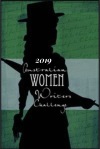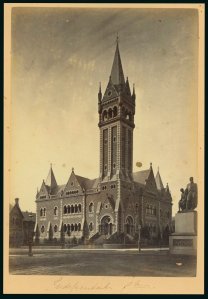When we think of Australian women during World War I, we tend to think of them as either nurses (and less often, doctors), or as sock-knitters. But there was a small group of Australian women, generally from middle to upper-class origins who did make their way overseas as volunteers with the Red Cross, or in the case of Rose Venn-Brown, as an administrator with the YMCA. The Armytage sisters from Como, for example, also made their way over there; so too did Vera Deakin. This book, written by Rose Venn-Brown’s grand-niece tells the story of one of these ‘Aussie girls’ in France between 1916 and 1920. Although the Red Cross also drew on her services, her main interest was the YMCA, and after the war ended she was attached to the Australian Graves Detachment based at Villers-Brettoneux in France.
When WWI broke out in August 1914, Rose was working as Assistant Registrar at the Royal Hospital for Women at Paddington. Coming from an affluent family, there was no economic necessity for her to work, but the family of thirteen (!) siblings seemed to gravitate towards white-collar professions after their father died quite early. She would have been expected to resign on marriage, but the war intervened, and marriage never beckoned. She felt that her administrative skills might have been of use “over there”, but she was generally discouraged by the military authorities, who would only send trained nurses. Eventually she circumvented them by travelling to New Zealand and embarking from there as a civilian. Through contacts, she found herself commissioned with the task of organising the medical records of the Australian War Office in Horseferry Road, London. She was asked by the wife of the NSW Agent-General in London to help organize the War Comforts Fund Association for Australian soldiers (which so many women were involved with back home in Australia), and was offered canteen work for the Young Mens Christian Association (YMCA). As far as she was concerned, she didn’t travel all that way to do canteen work, but she pulled some strings to be appointed to look after the finances of the canteens, which had been in a poor state until then. By 11 April 1916, her permits were cleared to cross to France to work for the YMCA, something that men employed by the YMCA were not impressed by. The men called a protest meeting, and it was agreed that Rose would spend a certain amount of time working in the camps – which was, of course, exactly what she wanted in the first place.
Rose later published her letters back home, and her diaries from her time at the front. The author has drawn heavily on both of these sources, and Rose certainly wrote well. As a descendant rather than a historian, Sandra Venn-Brown does not interrogate these sources or their production in the same way that Janet Butler has done in Kitty’s War (my review here).
If Rose Venn-Brown were working today, we would call her an Events Organizer, as much of her work revolved around organizing lectures and concerts for the men in the YMCA ‘huts’ located behind the front. It was acknowledged that the men needed leisure activities as they cycled between periods on the frontline and then back at base, and she liaised with performers and lectures to schedule and stage these events and organized dances and concerts among the men themselves. By this stage, three of her brothers had enlisted and she enjoyed being able to catch up with them when she could. Much of her identity revolved being an “Aussie girl” and the comfort that the Australian troops drew from hearing a familiar accent from a “girl” who could just as easily come from their home towns. Travelling from one part of the Western Front to the other was not easy, and in a letter home Rose gave a graphic description of visiting Gamaches, 62 kilometres north of Amiens, in early 1919 when hostilities had ceased. The journey was about 190 kilometres but took a full day, with the car bursting into flames several times and requiring multiple repairs along the way.
She finally returned home, but lost money in organizing a tour for her friend Flora Sandes, an entertainer from Serbia, whom she met as part of her work for the YMCA in Europe. Rose seemed to have been afflicted by the restlessness that many soldiers felt on returning home, and after three years she left for Shanghai, then travelled back to England and France, where she revisited the old battlefields with a friend Daisy Daking, a leading folk dancer who was sent out from England to entertain the troops and teach folk dancing (a rather surreal image, I must admit, all those soldiers folk-dancing). In the 1930s she returned to be with her family, moving from one family member’s home to another. She never married and never had a family of her own. She died in Chatswood, aged 69, seen by some in her family as “a bit full of herself” and “strange”.
This book presented the “Aussie Girl” in a WWI context that was uncommon at the time, and now too, when the focus is more on soldiers and nurses. The book is interlaced with the author’s own commentary and recollections from various tours overseas, which gives it a more homely feel. The author has been badly let down in the proof-reading, because there are multiple errors that mar the text- a rather surprising oversight in a book published by Australian Scholarly Publishing. Nonetheless, as the blurb on the back says, it does give new insight into battlefield life during the Great War, and it has presented Rose’s own lively recollections and anecdotes to a wider audience.
My rating: 7/10
Sourced from: Yarra Plenty Regional Library in preparation for a presentation I gave to Heidelberg Historical Society about George Lort Phillips, a local man who ended up commanding the Australian Graves Services unit until 1921.







 I have included this on the
I have included this on the 



